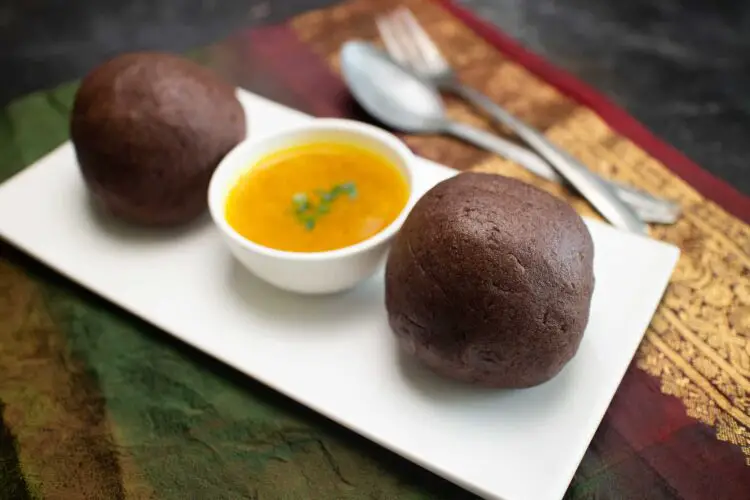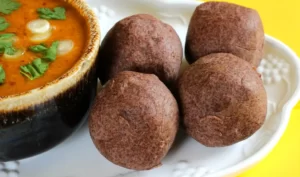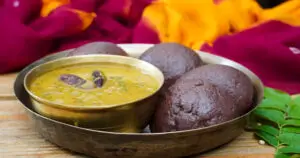Ragi Mudde recipe is a traditional dish from the southern Indian state of Karnataka. It is a nutritious and healthy dish made from finger millet flour (ragi flour) and water.
To prepare ragi mudde, ragi flour is first roasted lightly to remove any moisture and to bring out the nutty flavor. The flour is then mixed with water and cooked on low heat, stirring continuously until it forms a thick, sticky dough-like consistency. The dough is then formed into small balls using wet hands and served with a spicy vegetable or meat-based gravy.
Ragi Mudde is a traditional South Indian dish that originates from the states of Karnataka and Andhra Pradesh. It is a simple yet nutritious preparation made primarily from finger millet (ragi) flour and water. Here’s how Ragi Mudde is typically prepared:
ragi mudde can be served with
- Saaru: A spicy lentil-based soup with a tomato and tamarind base.
- Huli: A tangy and spicy vegetable-based curry made with a mix of coconut, tamarind, and spices.
- Majjige Huli: A yogurt-based curry with a mix of spices and vegetables.
- Soppu Palya: A dry vegetable stir-fry made with greens like spinach or amaranth.
- Chicken curry: A spicy chicken curry made with onions, tomatoes, and a mix of Indian spices.
- Mutton curry: A spicy mutton curry made with onions, tomatoes, and a mix of Indian spices.
- Fish curry: A tangy and spicy fish curry made with tamarind, coconut, and Indian spices.
- Eggplant curry: A spicy eggplant curry made with onions, tomatoes, and a mix of Indian spices.
Ragi mudde is a popular dish in rural Karnataka and is often a staple food. It is rich in fiber, calcium, iron, and other nutrients, making it a healthy choice for people of all ages
Ingredients for Ragi mudde
- 1 cup ragi flour (finger millet flour)
- 2 to 2.5 cups water
- Salt to taste
Instruction of Ragi mudde
- Heat a pan on medium heat and add ragi flour to it. Roast the flour for 5-7 minutes or until it turns light brown and gives off a nutty aroma. Keep stirring the flour continuously to prevent it from burning. Once roasted, remove from heat and set aside.
- In a separate pot, bring 2 cups of water to a boil. Add salt to taste.
- Reduce the heat to low and slowly add the roasted ragi flour to the boiling water, stirring continuously with a wooden spoon to avoid lumps.
- Keep stirring until the mixture starts to thicken and forms a soft, smooth dough. If the dough is too thick, add more water in small increments and continue stirring until it reaches the desired consistency.
- Cover the pot with a lid and let it cook on low heat for 10-15 minutes.
- Wet your hands with water and take a small portion of the dough to form a ball or mudde. Use your fingers to shape the ball into a dome or cone shape. Make sure the mudde is firm and smooth.
- Repeat the process to make more mudde.
- Serve hot with a spicy vegetable or meat-based gravy.
Tips:
- Use hot water when mixing the ragi flour to avoid lumps.
- Stir continuously when cooking the dough to avoid burning and achieve a smooth consistency.
- Wet your hands with water before shaping the mudde to prevent sticking.
- Serve the mudde immediately after cooking to avoid it becoming hard.
Variations:
- Masala Ragi Mudde: Add finely chopped onions, green chilies, and coriander leaves to the dough before shaping the mudde. This will add a spicy and flavorful twist to the traditional recipe.
- Ragi Mudde with Yogurt: Mix ragi flour with yogurt instead of water to make a softer and creamier version of the dish.
- Sweet Ragi Mudde: Add jaggery and grated coconut to the ragi flour and water mixture, and cook the dough until it thickens. This will create a sweet version of the dish that can be served as a dessert.
- Ragi Mudde Upma: Crumble leftover ragi mudde and sauté it with onions, tomatoes, and Indian spices to make a delicious and healthy breakfast upma.
FAQs
- Is Ragi Mudde healthy?
Yes, ragi mudde is a healthy dish. Ragi is rich in dietary fiber, calcium, iron, and other nutrients, making it a nutritious and wholesome food choice. It is also gluten-free and has a low glycemic index, which makes it an excellent option for people with celiac disease or diabetes.
- How is ragi mudde traditionally eaten?
Ragi mudde is traditionally eaten with wet hands by dipping it into a spicy vegetable or meat-based gravy. The dish is typically served for lunch or dinner in rural areas of Karnataka.
- Can ragi mudde be stored?
Ragi mudde should be consumed immediately after cooking. It is not recommended to store the mudde as it tends to become hard and lose its texture.
- What are some common side dishes that can be served with ragi mudde?
Common side dishes that can be served with ragi mudde include saaru, huli, majjige huli, soppu palya, chicken curry, mutton curry, fish curry, and eggplant curry. These dishes are typically spicy and flavorful, complementing the mild and nutty flavor of the ragi mudde
Conclusion
In conclusion, Ragi-Mudde is a traditional and nutritious dish from South India, particularly popular in the states of Karnataka and Andhra Pradesh. It is made from finger millet flour (ragi) and water, cooked to a dense, dough-like consistency. Ragi-Mudde is known for its health benefits, as ragi is a rich source of dietary fiber, protein, and essential nutrients.
This dish holds cultural significance in South India and is often served as a staple food. It is not only delicious but also provides sustained energy and aids in digestion. Ragi-Mudde is gluten-free and suitable for individuals with dietary restrictions.
Nutrition
| Calories | 168kcal |
| Fat | 17g |
| Fiber |
2g
|
| Iron |
0.2mg
|
| Carbohydrates | 2.2g |
| Protein | 2g |
| Vitamin A |
17IU
|
| Calcium |
10mg
|
You Might Also Like:
- Paneer do pyaza recipe
- Mushroom Pakoda recipe
- chicken chatpata recipe
- Oreo Mug Cake Recipe
- Paneer Dum Biryani Recipe
- Aloo paneer paratha recipe
follow us on Instagram, Facebook, andyoutube



